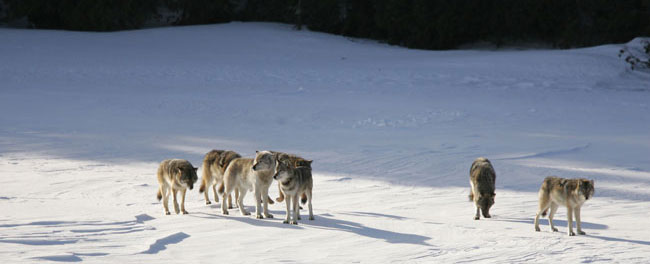
Wolves develop from pups at an incredible rate. Pups are born, in late April, after just a two-month pregnancy. They are born deaf, blind, and weigh no more than a can of soda pop. At this time, pups can do basically just one thing – suckle their mother’s milk.
Within a month, pups can hear and see, weigh ten pounds, and explore and play around the den site. The parents and sometimes one- or two- year old siblings bring food back to the den site. The food is regurgitated for the pups to eat. By about two months of age (late June), pups are fully weaned and eat only meat. By three months of age (late July), pups travel as much as a few miles to rendezvous sites, where pups wait for adults to return from hunts.
Pups surviving to six or seven months of age (late September) have adult teeth, are eighty percent their full size, and travel with the pack for many miles as they hunt and patrol their territory. When food is plentiful, most pups survive to their first birthday. As often, food is scarce and no pups survive.
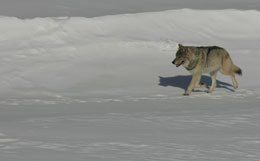
A wolf may disperse from its natal pack when it is as young as 12 months old. In some cases a wolf might disperse and breed when it is 22 months old – the second February of its life. In any event, from 12 months of age onward, wolves look for a chance to disperse and mate with a wolf from another pack. In the meantime, they bide their time in the safety of their natal pack.
From birth until his or her last dying day, a wolf is inextricably linked to other wolves in a complex web of social relationships. The ultimate basis for these relationships is sharing food with some, depriving it from others, reproducing with another, and suppressing reproduction among others.
Most wolves live in packs, a community sharing daily life with three to eleven other wolves. Core pack members are an alpha pair and their pups. Other members commonly include offspring from previous years, and occasionally other less closely related wolves.
Pups depend on food from their parents. Relationships among older, physically mature offspring are fundamentally tense. These wolves want to mate, but alphas repress any attempts to mate. So, mating typically requires leaving the pack. However, dispersal is dangerous. While biding time for a good opportunity to disperse, these subordinate wolves want the safety and food that come from pack living. They are sometimes tolerated by the alpha wolves, to varying degrees. The degree of tolerance depends on the degree of obedience and submission to the will of alpha wolves. For a subordinate wolf, the choice, typically, is to acquiesce or leave the pack.
Alphas lead travels and hunts. They feed first, and they exclude from feeding whom ever they choose. Maintaining alpha status requires controlling the behavior of pack mates. Occasionally a subordinate wolf is strong enough to take over the alpha position.

Wolf families have and know about their neighbors. Alphas exclude non-pack members from their territory, and try to kill trespassers. Mature, subordinate pack members are sometimes less hostile to outside wolves – they are potential mates.
Being an alpha wolf requires aggression, control, and leadership. Perhaps not surprisingly, alpha wolves typically possess higher levels of stress hormones than do subordinate wolves, who may not eat as much, but have, apparently, far less stress.
Pack members are usually, but not always friendly and cooperative. Wolves from other packs are usually, but not always enemies. Managing all of these relationships, in a way that minimizes the risk of injury and death to one’s self, requires sophisticated communication. Accurately interpreting and judging these communications requires intelligence. Communication and intelligence are needed to know who my friends and enemies are, where they are, and what may be their intentions. These may be the reasons that most social animals, including humans, are intelligent and communicative.
Like humans, wolves communicate with voices. Pack mates often separate temporarily. When they want to rejoin they often howl. They say: “Hey, where are you guys? I’m over here.” Wolf packs also howl to tell other packs: “Hey, we are over here; stay away from us, or else.”
There is so much more to wolf communication. Scientists recognize at least ten different categories of sound (e.g., howls, growls, barks, etc.). Each is believed to communicate a different, context-dependent message. Wolves also have an elaborate body language. As subtle as body language can be, even scientists recognize communication to be taking place by the positions of about fifteen different body parts (e.g., ears, tail, teeth, etc.). Each body part can hold one of several positions (e.g., tail up, out, down, etc.). There could easily be hundreds to thousands of different messages communicated by different combinations of these body positions and vocal noises. Scientists apprehend (or misapprehend) just a fraction of what wolves are able to communicate to each other.
Wolves also communicate with scent. The most distinctive use of scent entails territorial scent marking.
Elusiveness makes wolves mysterious. This is true and fine. However, true love cannot survive mystery due to ignorance. Mature love requires knowledge. In some basic ways the life of a wolf is very ordinary, even mundane, and its comprehension is fully within our grasp if we just focus.
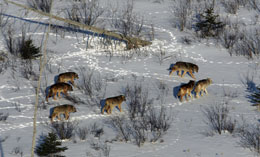
The life of a wolf is largely occupied with walking. Wolves are tremendous walkers. Day after day, wolves commonly walk for eight hours a day, averaging five miles per hour. They commonly travel thirty miles a day, and may walk 4,000 miles a year.
Wolves living in packs walk for two basic reasons - to capture food and to defend their territories. Isle Royale wolf territories average about 75 square miles. This is small compared to some wolf populations, where territories can be as large as 500 square miles. To patrol and defend even a small territory, involves a never-ending amount of walking. Week after week, wolves cover the same trails. It must seem very ordinary.
The average North American human walks two to three miles per day. A fit human walks at least five miles/day. If you want to know more about the life of a wolf, spend more time just walking, and while walking, know that you are walking. What do wolves think about much while walking?
Wolves defend territories. About once a week, wolves patrol most of their territorial boundary. About every two to three hundred yards along the territorial boundary an alpha wolf will scent mark, that is, urinate or defecate in a conspicuous location. The odor from this mark is detectable, even to a human nose, a week or two after being deposited. The mark communicates to potential trespassing wolves that this area is defended. Territorial defense is a matter of life and death. Intruding wolves, if detected, are chased off or killed, if possible.
Wolves are like humans for having such complex family relationships. Wolves are also like some humans in that they wage complete warfare toward their neighbors. An alpha wolf typically kills one to three wolves in his or her lifetime.
Because territories are a pack’s hunting grounds, giving up territory to other wolves is to give up food for the family. Territories are large enough to contain all the prey that a pack needs.
Between 1998 and 2000, Isle Royale’s Middle Pack (MP) increased from four to twelve wolves. During this period they expanded their territory westward, ultimately causing the extirpation of West Pack. This left Isle Royale with just two well-organized packs, and three pairs of wolves all trying to carve out a territory. In February 2000, a lone, dispersing wolf trespassed on the east end of MP’s territory. MP chased this wolf into the icy waters of Lake Superior, attacked it, and left it for dead. The lone wolf, a female, survived. A few hours later, a male wolf from MP found the female on the shore, stayed with it, and licked its wounds. We believe that this pair of wolves became the alpha pair of the Chippewa Harbor Pack (CHP). In the following years, CHP became a successful pack and caused MP to give up significant portions of its territory.
In 2006, East Pack (EP) killed the alpha male of CHP, who was ambushed at the site of a calf moose CHP had killed. Afterward, EP began to take over part of CHP’s territory. To the left, EP is seen examining a CHP scent mark on Chickenbone lake – disputed territory in 2006.
Much drama in a wolf community is attributable to territoriality and the behavior of tenacious and opportunistic wolves.
For most North American and European humans eating a meal is a pretty simple affair: get some food from the cupboard, heat it up, and eat. What if every meal required exerting yourself to the point of exhaustion, holding nothing back? What if every meal meant risking serious injury or death? Under these circumstances, you might be happy to eat only once a week or so – like Isle Royale wolves.
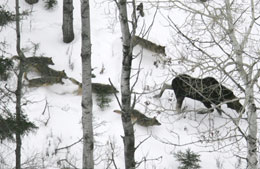
Isle Royale wolves capture and kill, with their teeth, moose that are ten times their size. Think about it for a moment – it is difficult to comprehend. A successful alpha wolf will have done this more than one hundred times in its life.
Wolves minimize the risk of severe injury and death by attacking the most vulnerable moose. Somehow wolves are incredible judges of what they can handle. Wolves encounter and chase down many moose. Chases typically continue for less than ½ a mile.
During chase and confrontation wolves test their prey. Wolves attack only about 1 out of every ten moose that they chase down. They kill 8 or 9 of every ten moose that they decide to attack. The decision to attack or not is a vicious tension between intense hunger and wanting not to be killed by your food.
Wolves typically attack moose at the rump and nose. The strategy is to inflict injury by making large gashes in the muscle, and to slow the moose by staying attached, thereby allowing other wolves to do the same. Eventually the moose is stopped and brought to the ground by the weight and strength of the wolves. The cause of death may be shock or loss of blood. Feeding often begins before the moose is dead.
A moose, with a wolf clamped to its rump is still formidable. They can easily swing around, lifting the wolf into the air, and hurl the wolf into a tree. Most experienced wolves have broken (and healed) their ribs on several occasions. Moose deliver powerful kicks with their hooves. Wolves occasionally die from attacking moose.
After a chase, wolves may kill and begin feeding within 10 or 15 minutes. Or they may wound and wait several days for the moose to die.
To some, wolves are evil for killing without cause and without eating much of what they kill. This is more a poor rationalization to justify killing wolves, than an observation rooted in fact.
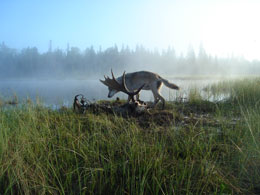
Typically, wolves consume impressive portions of their prey, eating all but the rumen contents, larger bones, and some hair. They routinely eat what you and I would not dream of eating – the stomach muscles, tendons, marrow, bones, hair and hide. They typically consume 80 to 100% of all that is edible. By wolf standards, every American deer hunter I know, including me, is wasteful. A wolf’s gut is not so different from ours that we can’t appreciate what it means to resort to eating such parts.
These eating habits make sense: starvation is a very common cause of death for wolves, killing prey requires a tremendous amount of energy and is a life-threatening prospect for a wolf.
Two circumstances give false impressions. First, it may take several days for a pack to consume a carcass, or they may cache it and consume it later. The ultimate utilization of what may appear to be a poorly utilized carcass is routinely verified by merely revisiting the site of a moose carcass at a later date.
Occasionally prey are unusually abundant, prone to starvation, and easy to capture. Under such conditions wolves may eat relatively small portions – only the most nutritious parts – of a carcass.
In this regard, wolves are no different from any other creature in the animal kingdom. Along migration routes during spring, when song birds many be extremely abundant, hawks sometimes kill many of these birds and eat only the organs, leaving behind all the muscle. Spiders suck a smaller portion of juice from their prey when prey are more common.
These are examples of an inviolable law of nature – utilization decreases as availability increases. The average American throws away about 15% of all the edible food that they purchase. Ten percent of our landfills are food that was once edible.
Finally, waste is a matter of perspective. What wolves leave behind, scavengers invariably utilize. Foxes, eagles, and ravens are among the most important scavengers on Isle Royale. However, even smaller scavengers may benefit greatly. To a chickadee, for example, a moose carcass is the world’s largest suet ball. Scavengers make waste an impossibility.
After feeding for a few hours on a fresh kill, wolves sprawl out or curl up in the snow and sleep. To eat a large meal with one’s family, and then to rest. To stretch out and just rest. When we observe wolves during the winter, about 30% of the time they are just sleeping or resting near a recent kill. Wolves have plenty of reason to rest.
When wolves are active, they are really active. On a daily basis, wolves burn about 70% more calories compared to typical animals of similar size.
While chasing and attacking a moose a wolf may burn calories at ten to twenty times the rate they do while resting. Its heart beats at five times its resting rate. For context, a world class athlete can burn calories at no more than about five times the calories they burn at rest. The intensity at which wolves work while hunting is far beyond the capabilities of a human.
While spending all this energy, wolves may eat only once every five to ten days. During the time between kills a wolf may lose as much as 8-10% of its body weight. However, a wolf can regain all of this lost weight in just two days of ad libitum eating and resting.
When food is plentiful, wolves spend a substantial amount of time simply resting, because they can. When food is scarce, wolves spend much time resting because they need to.
Wolves work tremendously hard, but they also take resting very seriously.
In some important ways, wolves and humans are alike. We are both social, intelligent, and communicative. In other ways, we differ. With thoughtful reflection, however, we can understand or imagine some of these aspects of a wolf’s life – their endless walking and their feast or famine lifestyle.
However, in a fundamental way wolves perceive a world that is simply beyond our comprehension and imagination. Through their noses, wolves sense and know things that we could never know.
We can build tools to help us visualize things we can’t see directly, like x-ray telescopes and electron microscopes. However, it is difficult to imagine a tool that would allow us to sense or experience the olfactory world experienced by the everyday life of a wolf.
Wolves have 280 million olfactory receptors in their nasal passages – more than the number of visual receptors in their retinas. Wolves can detect odors that are hundreds to millions of times fainter than what humans can detect.
A wolf often walks with its head down, nose close to the ground. Wolves rely on their noses for two of the most basic activities – hunting and communicating with other wolves. Smells, more than sights or sounds, determine where a wolf will travel next.
While hunting, moose are most often detected first by smell. Wolves commonly hunt into the wind, and by doing so can smell moose from 300 yards away.
A moose with jaw necrosis is vulnerable, and wolves can almost certainly smell that a moose has jaw necrosis before even seeing it.
The life of a wolf is difficult and typically, short. The chances of pup survival are highly variable. In some years, for some packs, most or all pups die. In other years, most or all survive.
Of the wolves that survive their first six to nine months, most are dead by three or four years of age. Every year, one in four or five adult wolves dies in a healthy wolf population.
Alpha wolves tend to be the longest lived. They commonly live for between six and nine years. Of the pups that survive their first year, only about one or two of every ten rise to the level of alpha. Most die without ever reproducing, and few wolves ever live long enough to grow old.
These rates of mortality are normal, even when humans are not involved in the death of wolves.
Wolves are intensely social. They are born into a family, and spend most of their time with other wolves. Wolves know each other and they know each other well. Imagine a world where it is common for one out of every four or five of the people you know to die.
The causes of wolf death are primarily lack of food and being killed by other wolves in conflict over food. This fact denies all credibility to perceiving wolves as wasteful gluttons, as they are often portrayed.
Most wolves die in the process of dispersing. Dispersal is a tremendous risk, but one worth taking. Ultimately, the only thing that matters is reproducing. Reproduction is very unlikely within the pack to which a wolf is born. It is better to risk death for some chance of finding a mate and a territory, than to live safely, but have virtually no chance of reproduction.